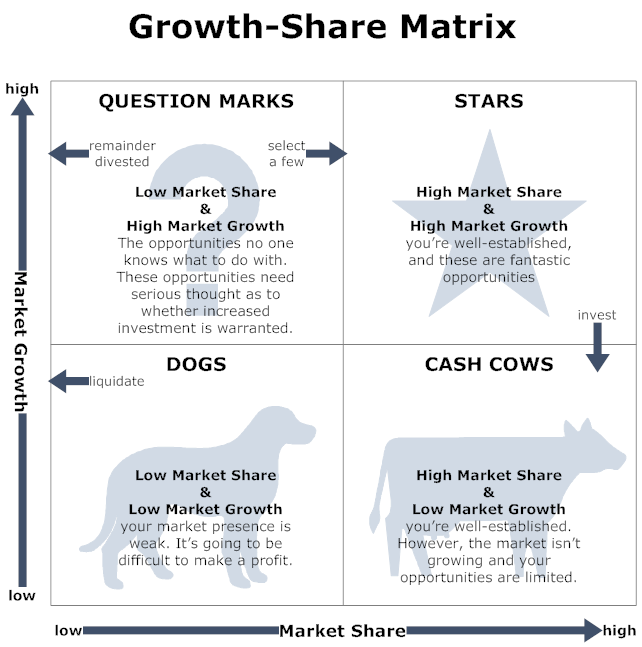 We are all quick to judge a company by the returns that it provides on our investment. What helps these businesses provide such returns is not a secret; it is often a mix of good management, marketing, luck, employees etc. But, what is it that distinguishes a company that could give high returns from another that could give decent, but steady returns for a longer period?
We are all quick to judge a company by the returns that it provides on our investment. What helps these businesses provide such returns is not a secret; it is often a mix of good management, marketing, luck, employees etc. But, what is it that distinguishes a company that could give high returns from another that could give decent, but steady returns for a longer period?
The BCG approach

The Boston consulting group’s model (BCG matrix) that helps to priorities the product portfolio of a business provides instructive insights towards this end. The matrix places products into four categories. Stars, which are in a high growth stage, also has high market share. They use up a lot of cash, but also bring back good revenue, having a high market share. Cash cows, also have high market share, but the growth is low. As the growth is low, investment needed is lower, but good revenue is generated on account of having a high market share. Dogs have low growth and low market share, for which expensive turn around plans are not ideal, and needs to be liquidated, if not sufficiently profitable. Lastly, Question Marks need the highest attention, as it requires high investment being in high growth category, but their returns are low, as market share is low.
It is a no brainer that it is “stars” that we would want to have, but if we can’t lay our hands on stars, “cash cows” are a must have. We would all want to own such companies that gives high returns, or at best give decent returns for a long period without fuss. But, how do we spot a star or a cash cow? None of the existing pricing models employed for stock picking do it well enough to identify a company that can be a star or a cash cow. Fundamental valuation approach looks at a possible mismatch between value and market price, while fractal analytics and technical analysis are predictive models on human behaviour. Other approaches like quantitative or derivative analysis are not much different either. So the process of identifying a star or a cash cow goes well beyond the stock’s price, present or future.
Engage
When, actor Sonali Bendre took to twitter to announce that she has been diagnosed with a high-grade metastatic cancer, fans and well-wishers poured in supportive comments on the social media. A few months earlier, actor Irrfan Khan had also taken to twitter to reveal that he had been diagnosed with neuro endocrine tumor, the public out-pour has been similar. And we are all familiar with cricketer Yuvraj Singh’s several trysts with cancer; there have been several instances of celebrities similarly reaching out to the public. But, why do we like to hear their stories, and why do we wish them well, though most of us hardly know them for real? Their online charisma is probably a reason, but certainly not the only, or not even the main reason. It is because; we would like to tell ourselves, through their recovery stories that we can be heroes in our own lies. When celebrities go public with their pain, they are not just following a global trend of such disclosures or because they are now increasingly facing difficulty in hiding their main events. Such engagement with the fans not only serves to ease the pain, but also serves to maintain the connection with the fans, which in turn ensures that when they come back, their brand image is embellished and enriched. Such communication also plugs the possibility of wrong information that could otherwise have diminished the brand image.
We have seen that stocks that have rewarded investors over a long period of time, are those that have been able to manage successful brands and have leaders who have been able to maintain a connect with the public or investors. No wonder, not all the stocks that constituted Nifty50 index ten years back remain with the index now. So, it is evident, that besides the obvious aspects of managing a successful business, it is imperative to maintain a connect with the customer to ensure longevity. From an investor perspective, it pays to look out for those companies that have managed to do that. This, though is subjective, but is nevertheless an important yardstick to estimate if a stock investment will end up as a cash cow or a shooting star.
Let me leave you with another thought, with a quick dab into quantum physics.
Schrodinger’s cat
[i]In Schrodinger’s experiment, devised in 1935, a cat is placed in a sealed box along with a radioactive sample, a Geiger counter and a bottle of poison. If the Geiger counter detects that the radioactive material has decayed, it will trigger the smashing of the bottle of poison and the cat will be killed. At the heart of Schrodinger’s experiment was an attempt to explain how average person could understand how a subatomic particle can exist as a combination of multiple states. Through the experiment, the flaws in a previous interpretation of the same were illustrated, which stated that a particle exists in many states until observed. In the case of Schrodinger’s cat, it would have meant that the cat is both alive and dead, until the box is opened, to see if radio active material has decayed or not or if the poison bottle is broken or not. There is an observer’s paradox here which means that until the observation is made, the cat has two realities: either dead or alive, or in other words, the observer here is the trigger for whether the cat will be alive or dead.
Stretching these scientific insights into to investor parlance, can it be said that a stock in one’s portfolio could be both a cash cow and a poor investment, at the same time, until the company-investor connection is made? Does it also follow that the very act of the investor making a connection or getting engaged with the company through observation, analysis or criticism, can alter the state of the company; i.e. being a cash cow or not? We can call this the “Investor paradox”. But it is increasingly becoming evident that, what analysts learn about the companies at minute level or fundamental level, and its relationship to what investors observe from a broader level, or how they make their buy/sell decisions has not been fully explored.
[i] https://www.telegraph.co.uk/technology/google/google-doodle/10237347/Schrodingers-Cat-explained.html









